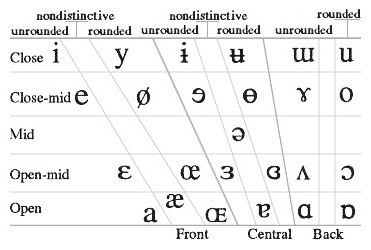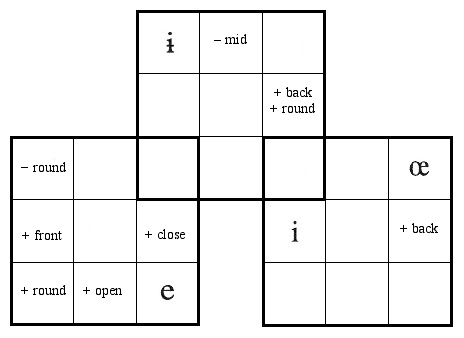 |
In the July issue, Speculative Grammarian continued its shameless attempt to cash in on the popularity of the Japanese number/logic game SuDoku by concocting another more-
Our last LingDoku puzzle, a step up in complexity from the original overly-
From the six correct solutions submitted, six winners were chosen:
Cindy Almond of Rockford, Illinois
Del Barrett of London, England
Cathy Bow of Melbourne, Australia
David Peterson of Garden Grove, California
Keith Slater of Lanzhou, China
Esme Winter of Tübingen, Germany

Minimalist |
In this final installment of the LingDoku Puzzle Trilogy, we at SpecGram have once again pushed the evolution of the linguist’s logic puzzle to the next level, bringing forth the ultimate in IPA-
Samurai LingDoku extends yet again the previous simpler LingDoku puzzle forms. Rather than nine or sixteen IPA symbols, Samurai LingDoku uses twenty-
The rules of Samurai LingDoku are complex, but rewardingly so. Using the twenty-

For purposes of this puzzle, some liberties have been taken with the vowel chart. There is no theoretical axe to grind here, just some puzzle-
In the puzzle below, some symbols are given to get you started. Also, for a number of squares, rather than giving a whole symbol, only one or two pertinent features of the symbol are given. Note: for the

Polysemy |
A strategy hint: using normal SuDoku techniques, you can solve some of the puzzle separately for height, frontness, and rounding. Once each feature is worked out as much as possible consider constraints on feature combinations. Pay attention to allowable and unallowable combinations. For example, if a box contains a symbol that is both central and rounded, you know its height is not “open”.
Those of you who find Samurai LingDoku “too difficult” should take comfort in the fact that you are not alone, but you might still shy away from any serious work in phonology and syntax. Those of you who think Samurai LingDoku is not all that tough should email your solutions to SpecGram. At least one random winner chosen from among those who send in correctly completed puzzles by December 1st, 2006, will earn a SpecGram magnet.
The solution (all the usual disclaimers of quality apply) and the name of the prize winners (if any) will appear in the upcoming January 2007 issue.
